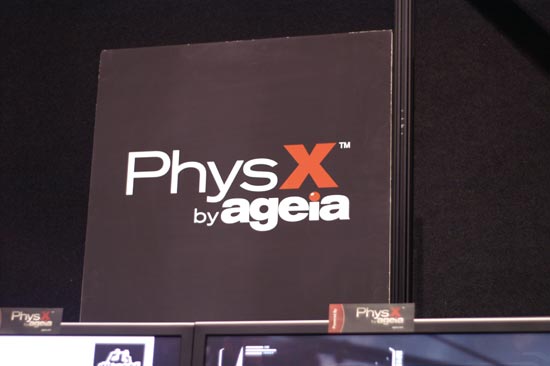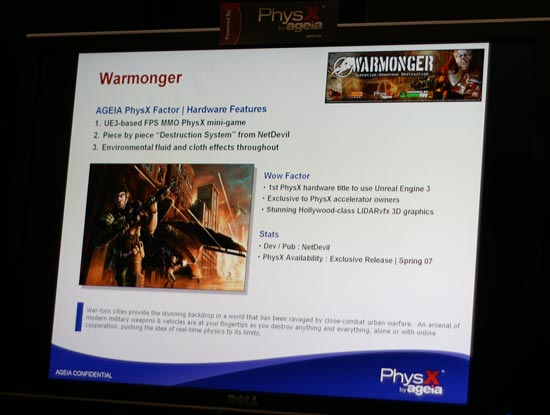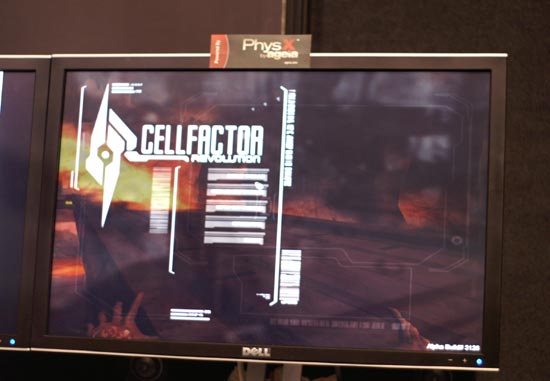CES 2007 Part I: Convergence Happened and the Most Impressive Demo of CES
by Anand Lal Shimpi on January 11, 2007 6:53 PM EST- Posted in
- Displays
Ageia has big plans for PhysX in '07
We met with Ageia at the show to go over plans for its PhysX accelerator and if there’s a future for the technology given the rocky start.

Ageia had no issues admitting that the PhysX launch wasn’t very good, so it is committed to fixing problems and doing whatever it can do correct the negative image of the first physics accelerator in 2007.

According to Ageia, 2007 will be a year of really ramping up the quality and quantity of games that implement PhysX support. Ageia hopes to achieve better overall quality through three major steps that are currently being implemented:
1) All PhysX titles that are released must go through some sort of an approval process before they can ship. This gives Ageia some input into the game development process and will hopefully mean that Ageia can pull support if a game doesn’t meet its standards. On the flip side, it also means that if mediocre PhysX implementations make it into games that Ageia will no longer be able to simply blame the developer; in the future, Ageia will be just as responsible as the developer.
2) Performance of a game with PhysX enabled must not be lower than with it disabled - you should no longer have the problem of better physics but lower performance. This is a big step forward for Ageia, as it is difficult to justify spending money on getting better physics if you end up reducing overall game performance as a trade off.
3) PhysX enabled titles must offer some sort of significant improvement with hardware acceleration enabled. Once again this is a sort of certification or stamp of approval by Ageia that the use of PhysX hardware will actually do more for your gameplay than make a nice tech demo.

Ageia remained fairly vague in how strictly it plans to enforce these requirements, but now it must share the responsibility if PhysX continues to be a failure by the end of 2007. According to Ageia, there will be three AAA game titles released before the end of 2007 that will make substantial use of its PhysX card, above and beyond anything that has been done to date.
Keep in mind that the PhysX core is still built on a 130nm process, so there’s room to reduce cost considerably. Ageia views the current PhysX implementation as a high end offering and plans on introducing lower cost variants to target other markets.
We left the Ageia meeting with a fairly strong statement from the company; by the end of 2007 Ageia expects the question of whether or not a PhysX card does anything to go away completely thanks to much better implementations in games and much better title availability.










18 Comments
View All Comments
Johnmcl7 - Friday, January 12, 2007 - link
Can't say I agree with that, while LCDs are thin and light their image quality leaves a lot to be desired especially given the superior image quality of the CRTs they've effectively replaced.John
PrinceGaz - Sunday, January 14, 2007 - link
That very much depends on the type of LCD panel used. Maybe it's because my Mitsubishi 2070SB CRT display is about four years old and isn't as good as it used to be, but the overall image quality (including colour reproduction) of my new HP LP2065 which uses an S-IPS LCD panel is just as good as it. The response-time is also sufficiently fast that their is no visible blurring of fast moving images. And the 2070SB wasn't some cheapo CRT either, it was one of the best 20" visible CRT monitors you could get.The fact that the LP2065 was just a little over half the price of the old 2070SB actually makes modern LCD displays seem superior to CRTs, especially when the lower power consumption is factored in. It is also slightly (ahem!) less bulky and heavy than the old CRT monitor. It makes me wish I'd switched to an LCD sooner except of course that even a year or two ago, the picture quality of the best LCD panels wasn't anywhere near what it is today.
Give a *good* (in other words one that does not use a TN panel) LCD display a chance and you'll probably be surprised.
msva124 - Monday, January 15, 2007 - link
Does it scale well to different resolutions? I.E. for gaming.tumbleweed - Thursday, January 11, 2007 - link
"the display is superb, making it very similar to reading pages in a regular book"Hardly. It's dark grey on light grey, thus having less than stellar contrast. No, this really isn't similar to reading a regular book; it's similar to reading an ATM receipt. Once they get it to the point of true blank on something resembling white, then we can talk. Other than that, I'll admit it's nifty, but the display quality ain't there yet.
msva124 - Thursday, January 11, 2007 - link
OMG! It's almost as good as one as those CRT things that Nostradamus said would be here in the year 3000!GhandiInstinct - Thursday, January 11, 2007 - link
I AM SOLD ON OLED!!!!! Come get me!BladeVenom - Friday, January 12, 2007 - link
Last time I checked, OLED displays had a very short lifespan. That may be OK if you don't use it much, or like replacing your monitor every year, but I think many will have a problem with that.psychobriggsy - Friday, January 12, 2007 - link
They've even got blues up to >30k hours now. That's a lot of TV watching, although some people sure do like to watch TV all day.Anyway, I'm sure I read that these Sony displays used a single colour OLED throughout, with colour filters on top. White OLEDs can have very long lives. If they're using 100k hour OLEDs, and you have the TV on for 10 hours a day because you cannot bear the idea of not having it on, then that is 30 years before the display is ~half as bright as originally. I think that predicting television display technology in 2037 will be quite difficult.
I'm just hoping that one day OLEDs will actually really be available in large displays! Can't wait yet another 5 years...